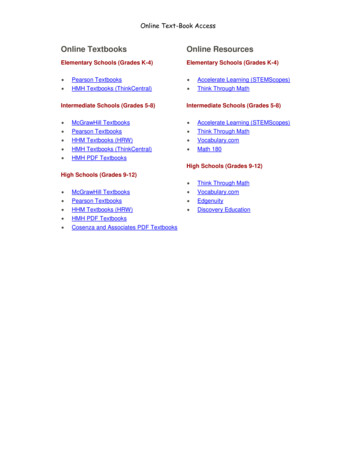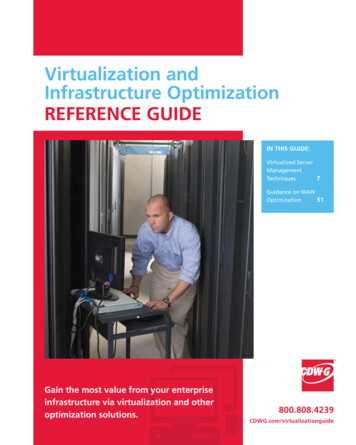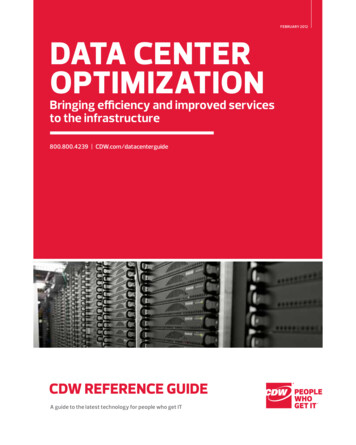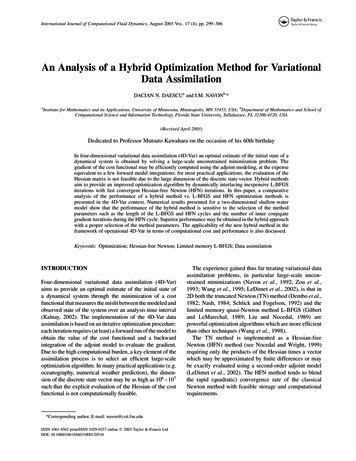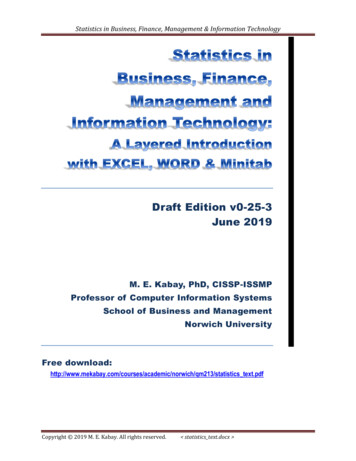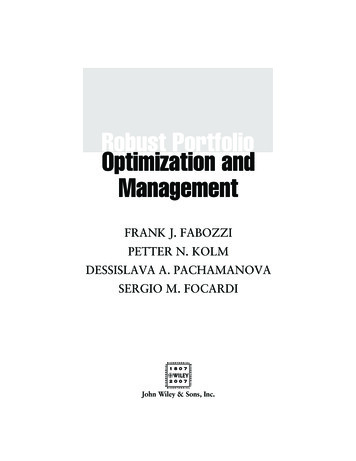
Transcription
Axioma Research PaperNo.February 19, 2015Multi-period portfolio optimization with alphadecayDRAFTThe traditional Markowitz MVO approach is based on a singleperiod model. Single period models do not utilize any data ordecisions beyond the rebalancing time horizon with the result thattheir policies are myopic in nature. For long-term investors, multiperiod optimization offers the opportunity to make wait-and-seepolicy decisions by including approximate forecasts and long-termpolicy decisions beyond the rebalancing time horizon. We considerportfolio optimization with a composite alpha signal that is composed of a short-term and a long-term alpha signal. The short-termalpha better predicts returns at the end of the rebalancing periodbut it decays quickly, i.e., it has less memory of its previous values.On the other hand, the long-term alpha has less predictive powerthan the short-term alpha but it decays slowly. We develop a simpletwo stage multi-period model that incorporates this alpha model toconstruct the optimal portfolio at the end of the rebalancing period. We compare this model with the traditional single-periodMVO model on a simulated example from Israelov & Katz [12] andalso a large strategy with realistic constraints and show that themulti-period model tends to generate portfolios that are likely tohave a better realized performance.
Multi-period portfolio optimization with alpha decayMulti-period portfolio optimization with alphadecayKartik Sivaramakrishnan, Vishv Jeet, and Dieter Vandenbussche1IntroductionDRAFTThe traditional Markowitz MVO approach is based on a single-period setting that limits itsapplicability to long-term investors with liabilities and goals at different times in the future.Single-period optimization does not use any data and decisions beyond the rebalancing timehorizon with the result that its policies are myopic in nature. More importantly, singleperiod optimization does not account for the fact that a decision made in a rebalancingtoday affects decisions made in future rebalancings. This is a drawback even if the rebalancing is done periodically in light of new information. A multi-period model has severalstages with the first stage representing the current rebalancing and stages two and beyondrepresenting future rebalancings. The model allows the simultaneous rebalancing of a singleportfolio across different periods (extending beyond the rebalancing time horizon) in a singleoptimization problem. Each stage in the model has its own data forecasts, objectives, andpolicy decisions and the stages in successive periods are coupled together. In most cases,we are only interested in the first-stage solution since the solution to the remaining stagescan be updated as new information becomes available. The first-stage solution to the multiperiod model incorporates a wait-and-see feature, since it is aware of future decisions anddata forecasts through the other stages in the model.One issue with multi-period models is that they require forecast information beyond therebalancing time horizon that is subject to greater uncertainty. A second issue is that theresulting model is complex and requires greater solution time. Despite these issues, multiperiod models have generated a lot of interest in the financial community since they attemptto model the future dynamics of the portfolio taking into account data and decisions beyondthe rebalancing time horizon. This leads to better solutions implemented today than wouldbe possible with a myopic single-period model.Multi-period models have found several applications in finance. The following list is byno means exhaustive.1. Trade scheduling: This is a common problem that is handled by large sell-side firmsand investment banks. A trade scheduling problem aims to get from an initial portfolioto a target portfolio in stages while trading off the risk and market-impact across allthese stages. The risk term in the objective forces the trading to happen quickly (moveAxioma2
Multi-period portfolio optimization with alpha decayslowly and the market will move you!). The market-impact term in the objective slowsdown the trading to avoid the market prices moving in an unfavorable fashion (movequickly and you will move the market!). One must consider implementation shortfall,which is defined as the difference between the prevailing portfolio price and the effectiveexecution price for the proposed trade schedule. In a seminal paper, Almgren & Chriss[1] minimize the first two moments of implementation shortfall in a Markowitz meanvariance framework to determine the optimal trade schedule. They show that the firstmoment of the implementation shortfall models the market-impact and the secondmoment of implementation shortfall models risk. A similar model is also consideredin Grinold & Kahn [10]. Multi-period models that only trade-off market-impact andtime varying alpha are considered in Bertsimas & Lo [4]. The market-impact is usuallya non-linear power function (quadratic, three-halves, five-thirds) of the transactions(see Almgren et al. [2] for more details). Almgren & Chriss consider a quadraticmarket-impact model and do not include realistic constraints (such as long-only) forthe different stages in their multi-period model. Consequently, their model resemblesthe classical LQR problem from optimal control and they are able to derive a closedform solution for their model by solving an algebraic Riccati equation.DRAFT2. Transition management and dynamic benchmark tracking: This is a passivemanagement framework where the aim is to track a benchmark or target portfolioclosely over time while minimizing the tracking error and market-impact across severalstages. Some of the stages can also include potential cash flows and portfolio injections.This is a common problem faced by large ETF providers who receive cash inflows andportfolios from investors over time and need to track a dynamic index closely. Blakeet al. [5] provide a good overview of multi-period optimization models in this area.3. Tax-optimization: Taxes are special transaction cost models that penalize sales.Moreover, short-term gains are taxed at a substantially larger rate than long-termgains. Multi-period models can be used to delay the sale of assets in the portfolio inorder to take advantage of the long-term rates. The multi-period tax optimization isespecially challenging since the tax liability is a function of both the current share priceas well as the prevailing price when the asset was purchased. Multi-period portfoliotaxes models are considered in DeMiguel & Uppal [6] and more recently in Haugh etal. [11].4. Alpha-decay: This is the application that we consider in this paper. In a typical portfolio application, the composite alpha signal is a composition of signals withdifferent strengths and decay rates. Usually, the signals that carry more information decay quickly. In an influential paper, Garleanu & Pedersen [7] consider an unconstrained infinite-dimensional multi-period model that trades off risk, return, andquadratic market-impact. This model provides an opportunity to trade-off the strengthof the fast decaying signals and the persistence (memory) of the slow decaying signals.Garleanu & Pedersen construct an optimal policy for their model using dynamic programming. We discuss their model in some detail in Section 3.Axioma3
Multi-period portfolio optimization with alpha decayDRAFTWe consider a simple variant of the alpha-decay use case in this paper. The investor hasan alpha that is composed of two signals: (a) a short-term signal that better predicts thereturns at the end of the rebalancing time horizon but decays quickly, i.e., the signal in thenext rebalancing period is very different to the one in the current period, and (b) a long-termsignal that has more memory, i.e., the signal in the next rebalancing period is similar to theone in the current period but is poorer at predicting the realized returns at the end of therebalancing period than the short-term signal. A short-term investor who only chases theshort-term signal would incur high turnover as he rebalances his portfolio over time. This willeat into his returns. The long-term investor who only chases the long-term signal is giving upthe valuable alpha in the short-term signal. So the dilemma faced by the investor is this: Howdo I trade-off the strength of the short-term signal and the slow-decay of the long-term signalwhile satisfying all my other mandates? We consider a simple two-stage multi-period modelthat is embedded in a rolling-horizon backtester to address this question. The backtestersolves a two-stage multi-period model in each period and returns the first-stage portfolio asthe final holdings. These holdings are then rolled-forward using the actual realized returnsand a new two-stage multi-period model is solved in the next period and so on. To avoidany confusion, we will use periods to represent the different time periods (iterations) in thebacktest and stages to represent the different rebalancings in a point-in-time multi-periodmodel. Our model is inspired by the work in Garleanu & Pedersen [7] but we also considerrealistic portfolio constraints in each stage of the model. We must emphasize that one needsan optimizer to solve a multi-period model with realistic constraints. The model no longeradmits a closed form solution and also specialized approaches such as dynamic programmingno longer apply.There has been a lot of other work in the alpha-decay case. Israelov and Katz [12] developan interesting informed trading heuristic that uses uses the short-term alpha signal to timethe portfolio’s trades; specifically, they continue with a trade only if both short-term andthe long-term components of the composite alpha signal agree on the direction of the tradeand otherwise cancel it. They test their heuristic on a realistic example and a simulatedexample with promising results. Grinold [8, 9], Qian et al. [13], and Sneddon [14] each solvea static auxiliary problem that trades-off signal strength and time decay to determine thesignal weights. These weights are then used in a single-period model to generate the portfolioholdings.This paper is organized as follows: Section 2 introduces multi-period portfolio models.Section 3 gives a brief overview of the Garleanu-Pedersen model that is the inspiration forour work. Section 4 presents our rolling-horizon two-stage multi-period algorithm for thetwo alpha problem. Section 5 compares the performance of our multi-period algorithmwith a single-period backtester on a simulated example that is taken from Israelov & Katz[12]. Section 6 presents our computational experiences with the multi-period algorithm ona large strategy with realistic constraints. Section 7 presents our conclusions. The technicalappendix gives the mathematical details of some of our main results.Axioma4
Multi-period portfolio optimization with alpha decay2Multi-period modelsConsider the following two-stage multi-period modelTmax (α1 )T w1 δTC( w1 ) γ(w1 )T Σw1 E [α2 ] w2 δTC( w2 ) γ(w2 )T Σw2s.t. w2 (1 r)w1 w2 ,w1 w0 w1 ,w1 C1 ,w2 C2(1)that trades off risk, return, and transaction costs across two stages. The variables w1 andw2 represent the final holdings of the portfolio and w1 and w2 represent the trades madein the first and second stages of the model, respectively. The initial holdings w0 are known.The first set of equations describe the final holdings of the portfolio in the second stage asthe rolled-forward holdings from the first stage plus the trades made in the second stage.Note that these equations actually couple stages one and two. The third and the fourthset of equations represent the constraints that the portfolio must satisfy in the first andsecond stages of the model. We will hereafter refer to these set of constraints as independentconstraints since they only involve the holding and the trade variables of a stage.The inputs to the multi-period model include:DRAFT1. w0 - the initial portfolio holdings vector.2. α1 - the alpha vector for the first stage.3. E [α2 ] - the expected alpha vector for the second stage. The expected alpha dependson the choice of our alpha uncertainty model and we present some details when weconsider our two alpha model in Section 4.4. TC( w1 ) and TC( w2 ) that represent the transaction cost (TC) models for the firstand second stages, respectively. Each TC model is associated with a coefficient δ inthe objective function.5. The risk model Σ and the risk aversion coefficient γ. For simplicity, we will assumethat both stages use the same risk model and risk aversion coefficient.6. The estimate r for the roll-forward returns. The portfolios generated by the multiperiod optimization are sensitive to this choice!7. The independent constraints in the first and second stages.The first stage of the multi-period model represents the current rebalancing that the investoris interested in. The length of this stage corresponds to the rebalancing time horizon thatthe investor would consider in a single-period setting. The investor knows that she willbe rebalancing their portfolio in the future and the second stage of the multi-period modelrepresents this future rebalancing with its own data estimates and decisions. Note that theAxioma5
Multi-period portfolio optimization with alpha decaydecisions made in the second stage are a function of the decisions made in the first stage andthe data for the second stage. The objective terms in the second stage of the multi-periodmodel are usually discounted in practice as they represent rebalancings that are farther outin time. Note that w2 really represents the expected second stage portfolio holdings sincethe alpha for this stage is not known precisely. We are especially interested in the first-stageholdings w1 since the holdings from the second stage can be updated as more informationbecomes available. We want to know how the data and the decisions in the second stage ofthe model help us make informed decisions in the first stage. Finally, we must emphasizethat it is hard to come with good roll-forward estimates for the multi-period model and wewill assume that r 0 throughout this paper.3The Garleanu-Pedersen modelWe briefly describe the Garleanu-Pedersen multi-period portfolio model [7] that incorporatesalpha-decay in this section. Consider a composite alpha signal over n assets that is composedof k factors with varying decay rates. The composite alpha in stage j of the multi-periodmodel is given byαj Bf j(2)DRAFTwhere the factors evolve asf j (I φ)f j 1 j(3)where Φ is a diagonal matrix of factor decay-rates and j is a random variable with zero meanand finite variance. Garleanu and Pedersen consider the following unconstrained infinitedimensional multi-period portfolio problem to determine the trades (w1 , w2 , . . . , )! X δ γTTwt Σ wt(4) wt Σ wt (αt )T wt max E1w1 ,w2 ,.22tthat trades off the present value of all the future excess expected return (alpha), risk, return, and transaction costs. 1 The expectation is taken over the random αt . The risk isrepresented by the variance of the portfolio returns, where Σ is the asset covariance matrix.The transaction costs are modeled by a quadratic function with the costs proportional torisk. This assumption enables us to derive a simple closed form solution for the model. Thepositive scalars γ, δ represent the risk and TC aversion parameters, respectively. Using thelaw of total expectation, we can write the objective function in (4) as Eα1 OBJ1 Eα2 α1 OBJ2 Eα3 α1 ,α2 OBJ3 . . . (5)whereOBJj 1 T T γδ wj Σ wj (αj )T wj wj Σ wj22We are neglecting the discount term in the Garleanu-Pedersen model to simplify the exposition.Axioma6
Multi-period portfolio optimization with alpha decayis the objective function in stage j. The outer expectation Eα1 in (5) is the expectation overthe random α1 , the inner expectation Eα2 α1 is the conditional expectation of α2 with α1known, and Eα3 α1 ,α2 is the conditional expectation of α3 with α1 and α2 both known andso on.The Markowitz portfolio at stage j that only trades off risk and return during this periodis given byMVj (γΣ) 1 Bf j(6)Consider an investor who performs the following single-period optimizationTTmax(αj )T wj γ2 (wj ) Σ (wj ) 2δ ( wj ) Σ ( wj )jw(7)in stage j with initial holdings wj 1 where wj (wj wj 1 ). The optimal single-periodportfolio for this investor is given byjwspo γδwj 1 MVj .γ δγ δ(8)DRAFTGarleanu & Pedersen [7] use dynamic programming to derive an expression for the portfolioholdings in the different stages. They show that the optimal portfolio at stage j is a j 1 awj 1 w TARj(9)δδwherepγ 2 4γδ γa 2(10)is a positive scalar and TARjf j,1 φ1 a1 γ . (γΣ) 1 B . j,k f φk a1 γ (11)is the target portfolio that trades off risk and return. Comparing (8) and (9), we see that theoptimal multi-period portfolio uses the target portfolio instead of the Markowitz portfolio atstage j. Moreover, the target portfolio is basically the Markowitz portfolio with each factorscaled down by its decay rate.Axioma7
Multi-period portfolio optimization with alpha decay4Two alpha multi-period modelWe apply the two-stage multi-period model that we introduced in Section 2 to the two alphacase in this section. The composite alpha signal in the model is constructed from (a) a strongand rapidly decaying short-term signal, and (b) a weak and persistent long-term signal.We embed this multi-period model in a rolling-horizon backtester. Our model resembles the model predictive approach (see Chapter 6 in Bertsekas [3]) to solving stochasticmulti-stage problems where one (a) solves a sequence of deterministic two-stage multi-periodmodels conditional on the available information, (b) implements only the first-stage solution, (c) refines the second-stage solution with new information as it becomes available.One can show that the multi-stage rolling-horizon backtester generates the same trades asthe dynamic programming approach of Garleanu-Pedersen for the unconstrained case withquadratic transaction costs and the same number of stages. On the other hand, the rollingbacktester can incorporate realistic constraints and different transaction cost models (linear,piecewise-linear, three-halves) in the multi-period model, where closed-form solutions are notavailable and dynamic programming is no longer a viable approach. We must also emphasizethat our rolling-horizon model is a heuristic approach to solving the stochastic multi-stagemodel with realistic constraints. It is however known to generate good solutions in practice(see Bertsekas [3]).The alpha signal in stage j of the multi-period model at time t is given byDRAFTαt,j λjs αst λjl αlt(12)where αst , αlt are the short-term and long-term alpha signals and λjs , λjl are their associatedweights. Furthermore the signal follow a first-order autoregressive process given byαsj σs αsj 1 js ,αlj σl αlj 1 jl ,(13)where σs , σl (0, 1) denote the short-term and long-term autocorrelations and ts and tldenote random short-term and long-term innovations with zero mean and finite variance.Note that (13) resembles the Garleanu-Pedersen alpha-decay model, where we assume thatthe uncertainty is baked into the signals themselves. The autocorrelations measure how closetoday’s signal is to yesterday’s signal while the innovations represent the new informationflowing into the signals in each period. We have λs λl since the short-term signal betterpredicts the immediate returns, i.e., the returns at the end of the previous period. On theother hand, we have σs σl since the long-term signal has more memory. From (13), wecan compute the conditional expected alpha in the next period given the current alpha asE [αsj αsj 1 ] σs αsj 1 ,E αlj αlj 1 σl αlj 1 .(14)We are now ready to pre
Axioma Research Paper No. February 19, 2015 Multi-period portfolio optimization with alpha decay The traditional Markowitz MVO approach is based on a single- . moment of implementation shortfall models risk. A similar model is also considered in Grinold & Kahn [10]

